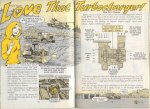I'm a little stumped here, so I re-read as Westex said, and heres my thoughts. Supose a multifuel takes a certain amount of revolutions after start-up before the oil arives at the galleys and initally starts lubing the bearings. Lets sa this amount of 'crankshaft' revolutions amount to say 600 complete revolutions before the oil is pumped, fills the cans and travels to the gally and then is directed to each bearing, and in just a moment all bearings are recieving oil..................................................OK, prior to that time the bearings are DRY, so from start-up time untill lube time, it's dependant on oil-pump revolutions to make the oil travel the distance it needs to go to finnaly hit the last bearing in the sequence of bearings, since its a pathway (the gally) and the oil arives at the first then the second then the third and so-on untill finnaly the last in that line of the oil flow is reached.....then of course you have uninterupred, constant oil flow to the entire system. SO.....My thinking is this: if you rev at startup, you risk higher abrasive loads on the bearing shells, and revving only gets the oil there quicker by virtue of (our time scale) not the motors time scale. since it takes a certain number of revolutions for the start of oil travel to come to the end of its destination.....either slow or fast revolutions of the crankshaft will have the oil ariving at the same time.......let me expound to clarify. We'll say the entire distance through the internals of the engine that the oil travels before it drains back to the sump is 4 inches of linear distance per 1 revolution and the entire path traveled through the oil gallys is 6 foot, each revolution will force the oil 4 inches, first r=4, second r=8, third r=12, fourth r=16 inches and so-on until the entire 6 foot is traveled. So reving does quicken in terms our our time, BUT it is ultimatly a matter of how far each revolution moves the oil through the path. And if we increase the rpm right from start, we increase harmonic load considerably, mabe ten-fold ......With-out oil......




 READ: zombie attack, or dad getting impatient
READ: zombie attack, or dad getting impatient